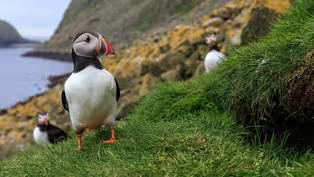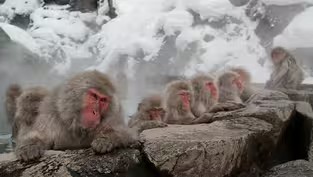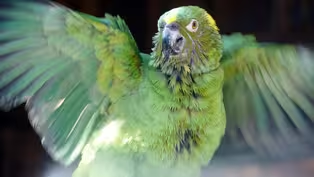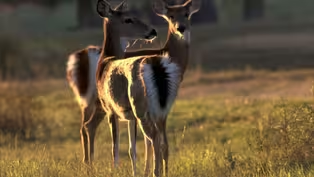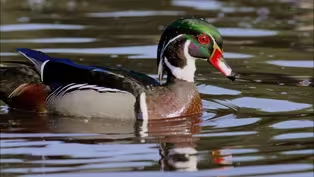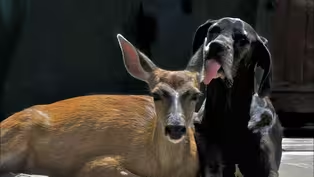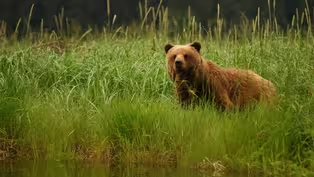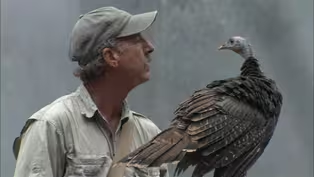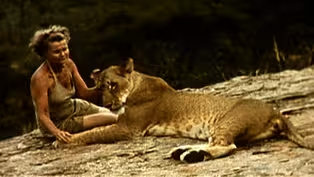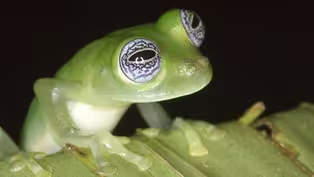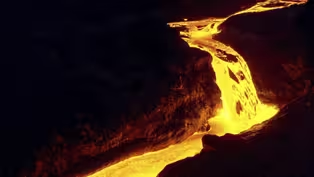
Yellowstone in Winter
Season 4 Episode 2 | 56m 38sVideo has Closed Captions
The winter solitude of Yellowstone National Park.
Wolfgang Bayer captures the winter solitude of Yellowstone National Park.
Problems playing video? | Closed Captioning Feedback
Problems playing video? | Closed Captioning Feedback
Major support for NATURE is provided by The Arnhold Family in memory of Henry and Clarisse Arnhold, Sue and Edgar Wachenheim III, The Fairweather Foundation, Charles Rosenblum, Kathy Chiao and...

Yellowstone in Winter
Season 4 Episode 2 | 56m 38sVideo has Closed Captions
Wolfgang Bayer captures the winter solitude of Yellowstone National Park.
Problems playing video? | Closed Captioning Feedback
How to Watch Nature
Nature is available to stream on pbs.org and the free PBS App, available on iPhone, Apple TV, Android TV, Android smartphones, Amazon Fire TV, Amazon Fire Tablet, Roku, Samsung Smart TV, and Vizio.
Buy Now
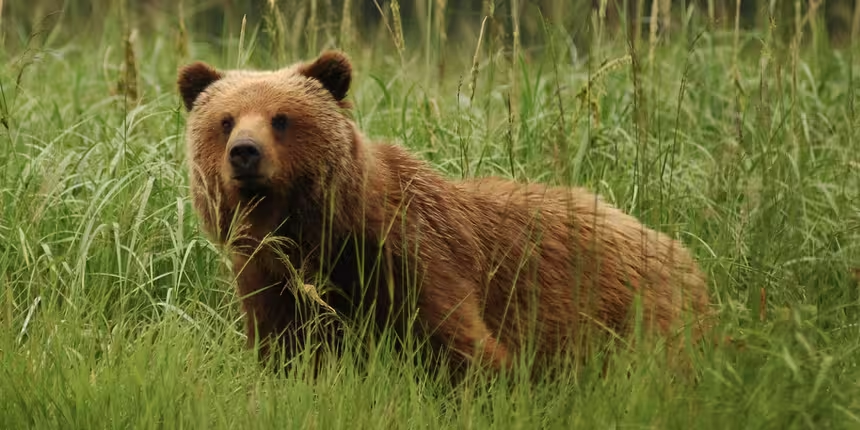
Explore More Ways to Watch
Bring the beauty and wonders of wildlife and natural history into your home with classic NATURE episodes.Providing Support for PBS.org
Learn Moreabout PBS online sponsorshipMore from This Collection
Watch classic NATURE episodes with the PBS station member benefit Passport.
Video has Closed Captions
Animals congregate in huge colonies partly out of necessity and partly for the security. (52m 55s)
Video has Closed Captions
Follow a troop of snow monkeys in Japan to see how they prepare to face the world. (52m 58s)
Video has Closed Captions
Parrots and the bittersweet world they share with humans. (53m 10s)
Video has Closed Captions
Learning about one of our closest neighbors: the white-tailed deer. (53m 10s)
Video has Closed Captions
Take a fascinating look at one of our most familiar birds. (1h 42s)
Video has Closed Captions
Love apparently knows no boundaries in the animal kingdom. (53m 20s)
Video has Closed Captions
Enter a world shaped by bears, trees, and salmon. (50m 9s)
Video has Closed Captions
One man's remarkable experience of raising a group of wild turkey hatchlings to adulthood. (58m 51s)
Elsa's Legacy: The Born Free Story
Video has Closed Captions
The true story that inspired "Born Free". (53m 10s)
Video has Closed Captions
It is the greatest mass extinction since the dinosaurs. (53m 43s)
Video has Closed Captions
Kilauea, on Hawaii's Big Island, is the world's most active volcano. (54m 6s)
Video has Closed Captions
Relationships with cats and dogs are some of the longest and most intimate of our lives. (53m 30s)
Providing Support for PBS.org
Learn Moreabout PBS online sponsorship[wind whooshing] [awe-inspiring music] [water whooshing] [awe-inspiring music] [swan honks] [awe-inspiring music] [awe-inspiring music continues] [awe-inspiring music continues] [awe-inspiring music continues] - Yellowstone is the largest and oldest of our national parks, most famous for its spectacular thermal features including the great geyser, Old Faithful, and other geyser basins such as this one.
Hi, I'm George Page for "Nature" and about 2 million visitors from all over the world come here to Yellowstone each year.
They're not disappointed.
But in truth, they don't see the park at its most spectacular in winter.
For five years, American natural history filmmaker, Wolfgang Bayer, has endured the harsh winters of Yellowstone to bring us scenes of a time when the park belongs not to man, but to the wildlife.
Tracking through the icy wilderness at temperatures as cold as 40 degrees below zero, Bayer approached the park from nature's point of view.
Like the hardy 19th-century photographers of the Western wilderness, Bayer reveals the natural rhythms of the great park in winter, which, for countless centuries, only the animals have known.
[wind whooshing] [wind whooshing] [bison grunting] [wind whooshing] [swans honking] [water whooshing] [water whooshing] [eerie music] [water burbling] [eerie music continues] In the early 1800s, tales of a marvelous land beyond the headwaters of the Missouri River began filtering back to the people in the Eastern United States.
[gentle music] The first white explorers who paddled up the Yellowstone River found an isolated wilderness, a land set apart from the rest of the world by its remote location.
[gentle music continues] The unique wonders of Yellowstone were not accepted by most as truth until the first photographs of the area were taken by explorers.
[gentle music continues] They saw valleys that seemed to smoke and burn perpetually.
A deep golden canyon.
A great waterfall twice the height of Niagara tumbling into the abyss below.
[water whooshing] Boiling hot pools.
[water burbling] Bubbling mud volcanoes, and geysers of steam bursting into the air.
It all had to be seen to be believed.
[steam hissing] And now, 100 years later, explorers of a different sort are still striving to capture Yellowstone in pictures.
Yellowstone National Park was established by an act of Congress in 1872.
The first such park in the world.
Over 3,400 square miles were set aside as a place for people to find the glories of nature in their original form.
[bison grunting] But the season of the tourist is short.
When fall comes to Yellowstone, only a few people remain.
The animals suddenly find themselves nearly alone in the park.
[hooves thudding] Ironically, it's then that Yellowstone becomes its most dramatic.
[wind whooshing] The lush green grasses of summer turn gold.
The chilly winds of fall provide a signal to the animals to begin preparations for the long arduous months of winter to come.
[bush rustling] The pika, small cousin of the rabbit, lives in the rocks and scree slopes of the mountains.
Exceedingly shy, the pika harvests leaves and grasses to build a mound of hay.
[birds chirping] Its home inside the rocks will keep it warm and secure and the ample store of harvested grass will feed it through the winter.
[birds chirping] [tree thuds] The trees the beaver fells provide branches covered with succulent bark.
[branches rustling] [birds chirping] [water whooshing] The beaver stores these branches underwater next to its lodge to ensure food in the winter months.
[birds chirping] [water whooshing] Last-minute repairs maintain a high level of water behind the beaver's dam.
Eventually, it will need room to swim beneath the frozen surface to reach its food.
[ominous music] The most famous resident of Yellowstone Park is the grizzly bear.
Though rarely seen, they roam over large areas of territory foraging for food.
[ominous music continues] Today there are only about 200 of the huge omnivores left in all of Yellowstone.
[ominous music continues] They feed on grass, grubs, and nearly anything else they can find in order to build a heavy layer of fat to live on as they sleep through the long cold months ahead.
[ominous music continues] [ominous music continues] [ominous music continues] By now, the elk have left the highlands of the park and have congregated in lower meadows for their annual rut or mating season.
[elk bugling] [elk bugling] The piercing bugle of the bull elk echoes through the forest.
Stimulated by the powerful pheromones emitted by the cows, the bulls compete to determine which is the strongest.
[gentle music] [antlers clacking] [gentle music continues] The victor then gathers his harem.
The one victorious bull will mate with all the females he can collect and, if necessary, rigorously defend them from other males.
[gentle music continues] [water whooshing] [gentle music continues] [gentle music continues] The first snow in the higher mountains drives the bighorn sheep to lower slopes where they can spend the remaining days grazing before winter.
This is also the rutting season for the bighorn.
[gentle music continues] Rams, which generally roam apart from the ewes, are drawn to the herd by the females' pheromones.
The biological stimulation is irresistible.
[gentle music continues] [gentle music continues] [hooves pattering] [hooves pattering] [hooves pattering] Even immature rams become stimulated, but the younger ram cannot compete.
[hooves pattering] [horns thudding] Only mature rams face each other in ritual combat.
[horns thudding] [horns thudding] [horns thudding] Like the bull elk, the victorious ram will mate with all the females.
After mating, it leaves the herd and returns to the mountains.
[wind whooshing] [wind whooshing] [geese honking] Birds also sense the approaching change of season.
Ducks and Canada geese gather into great flocks and begin their annual migration through steel-gray skies to the south.
[geese honking] [wings whooshing] [gentle music] The trees cannot escape winter.
[gentle music continues] [wind whooshing] [gentle music continues] [wind whooshing] After the first frost, the aspens' leaves become golden, then wither and fall.
[gentle music continues] [wind whooshing] [gentle music continues] [wind whooshing] The first snow begins to sift down between the naked branches.
Winter has arrived.
The lodgepole pines, firs, and other evergreens prepare for winter by lowering the water content and increasing the amount of sugar in their needles, creating a natural antifreeze.
The needles remain green and unharmed by the subzero temperatures.
[eerie music] The last human visitors to the park flee the harsh weather to come, and just in time.
The park officially closes with the first major snow storm.
[wind whooshing] [eerie music continues] [eerie music continues] The season's first blizzard is heavy, definite.
Winter begins to seal Yellowstone Park in ice and snow.
[car rumbling] Making one last sweep of the snow-clogged roads, a park ranger ensures there are no visitors left stranded in the snow.
[car rumbling] [wind whooshing] Nature has already closed the park.
The ranger makes it official.
[gate clanks] [car rumbling] - This is 700, pack it up.
- [Dispatch] 511, 700.
- We shut the road from Grant to south.
Barricade is locked for the season.
- [Dispatch] 10-4.
Thank you.
KLS, 700.
16-35.
- Thank you, 511.
[car rumbling] - [George] The roads won't be open again for automobiles until spring.
[wind whooshing] [gentle music] The first snows of winter are impressive, even frightening.
They seem never ending.
[gentle music continues] Yellowstone is a high plateau.
Storms rolling in from the Pacific Northwest are laden with moisture and Yellowstone catches the brunt of it.
[gentle music continues] [gentle music continues] [steam hissing] The snow transforms Yellowstone into a frosted masterpiece of sculpted snow and plumes of steam.
[steam hissing] Deep in the earth, beneath the ice and snow, water is super heated under pressure until the steam blasts hot white gusts into the winter air.
Old Faithful plays to an empty house.
[water burbling] The temperature of the pools is near boiling.
The steaming waters never freeze.
[water burbling] [birds shrieking] In the warmer valleys at lower elevations, Yellowstone's elk have a better chance of finding food.
[tense music] [tense music continues] Thousands of them converge on Jackson Hole, Wyoming and the National Elk Refuge.
They're better prepared to struggle through the winter here in their ancient feeding grounds.
[tense music continues] When the natural forage in the refuge is exhausted by the huge herd, the elk are fed by the U.S.
Fish and Wildlife Service.
Their manmade diet: pellets of compressed alfalfa.
[truck rumbling] [truck rumbling] [truck rumbling] [truck rumbling] [elk squeaking] As many as 8,000 elk winter beneath the majestic Tetons.
[elk squeaking] [gentle music] But for the animals remaining in Yellowstone, the worst is yet to come.
[tense music] [tense music continues] [wind whooshing] One after another, blizzards roll into the park like immense icy waves battering a beachhead.
[wind whooshing] The bison do not migrate.
They must stand and endure.
Groups of the giant ruminants huddle together trying to pool their warmth and provide each other with marginal protection from the biting winds.
[wind howling] [wind howling] [wind howling] In the freezing depth of winter, food is more essential than ever.
Nourishment translates to energy for essential body heat.
The bison's massive neck and head are well-suited to plowing through the drifts to uncover bits of frozen grass.
[snow rustling] Meager fare, but there's little else.
[bison grunting] A desperate yearling calf, unaccustomed to winter, tries to find food in a familiar place, but its mother cannot spare the nourishment.
She's probably already carrying next year's calf.
In the Yellowstone winter, all must find their own way.
[bison grunting] [wind whooshing] The calf must learn to imitate its elders and find a meal beneath the snow.
[wind whooshing] A few elk stay in the park.
They're not as well adapted to foraging in the deep snow.
But under the sheltering trees, they find easier grazing.
[wind whooshing] [wind whooshing] [snow rustling] The tourists have left Yellowstone to its frozen fate.
Man's artifacts have surrendered to the elements, but the buildings of the park must also survive the winter.
[wind whooshing] The tourists may be gone, but there's still a few hardy people left in the park.
[snowmobile rumbling] [snowmobile rumbling] Stephen Fuller is one of the winter caretakers.
It's his job to make sure the buildings and the park survive the extreme stress and wear of the heavy winter snows and winds.
[metal clattering] One of his more demanding jobs is removing snow from building roofs.
The tons of snow can crush a structure flat.
[shovel thudding] [shovel thudding] [shovel thudding] [wind whooshing] By December, Yellowstone has become a vast icy wilderness.
Winter has settled in with a finality that almost precludes the hope of spring.
[gentle music] The only sound in the pristine landscape is the labored breathing of the animals, quietly struggling to survive.
[gentle music continues] It's a time of deep silence and long, dark nights, but a special time in one small part of the park.
[gentle music] - 'Twas the night before Christmas and all through the house, not a creature was stirring, not even a mouse.
The stockings were hung by the chimney with care in hopes that St. Nicholas soon would be there.
The children were nestled all snug in their beds while visions of sugar plums danced in their heads.
And Mama in her kerchief and I in my cap had just settled down for a long winter's nap.
Do you wanna go and help Emma over there?
- [George] In their cabin in Yellowstone, Steve Fuller's family can create their own warmth.
For the moment, they've forgotten the winter outside.
- [Mrs. Fuller] But I heard him exclaim as he drove out of sight, "Happy Christmas to all and to all a good night!"
[eerie music] - [George] The New Year dawns in Yellowstone with an icy magnificence that is unequaled in the world.
[eerie music continues] Steam billows into the sky in the midst of temperatures that can reach 65 degrees Fahrenheit below zero.
Taking advantage of the warm waters overflowing the geyser basins, some waterfowl stay long into the winter.
As the ice slowly encroaches, the trumpeter swans become more and more crowded into smaller areas.
[swans honking] [swans honking] [swans honking] The trumpeter does not migrate, but adapts to the harsh conditions as long as possible.
[swans honking] [swans honking] [swans honking] The swans finally surrender to the Yellowstone winter and fly to find open water elsewhere.
[swans honking] [tense music] Meanwhile, predators like the coyote continue their search for prey in the blank expanse of blinding snow.
[tense music continues] [crow caws] [tense music continues] [gentle music] In the small pockets beneath it, many rodents, like this squirrel, hibernate through the winter.
Wrapped in tight balls, they retain their body warmth and reduce their metabolic needs to a minimum.
[gentle music continues] [gentle music continues] The pika's supply of cured grasses, carefully gathered in the fall, now provides ample food under the mantle of snow.
[pika snuffling] Its lodge as secure as a cozy cave, the beaver can ignore the howling winter outside.
The twigs and branches it stored under the water are its only food source until the ice melts.
[beaver snuffling] A gopher burrows under the ground, searching for roots.
The rodent's sharp claws enable it to dig for food even in the frozen soil.
[gopher rustling] Occasionally it must venture up into the snow to dispose of excess dirt from its tunnels.
[gentle music] The infinitely adaptable coyote hunts carefully through the drifts to save precious energy.
It tries to follow paths already cut in the snow.
[gentle music continues] Its keen ears pinpoint the high-pitched noises made by rodents tunneling under the snow.
[snow rustling] [gopher snuffling] [paws thudding] [paws thudding] [paws thudding] [paws thudding] [gopher rustling] [paws thudding] [melancholy music] Winter makes the struggle for survival much more intense.
Some must die so that others may live.
[melancholy music continues] Searching for food, the coyote crosses frozen Yellowstone Lake.
[melancholy music continues] [otters grunting] To the coyote, the sight of river otters means another possible meal.
[otters grunting] It's not the otters the coyote is after.
It's their fish.
The otters must eat above the surface, a fact the coyote has learned to exploit.
[water burbling] [otters grunting] Thermal vents in the lake create holes in the ice.
The coyote can be run in circles as the otters play hide and seek, ducking in and out of the convenient open water.
[otters grunting] [water burbling] [otters grunting] [water burbling] The frigid lake is an effective barrier and stealing the fish is more difficult than it seemed.
[water whooshing] [raven cawing] Another scavenger, the raven, can drop with impunity on the edge of the ice, picking up bits of food [water burbling] [otters grunting] But the coyote knows better than to venture out onto the fragile surface.
The otters keep their fish.
The coyote gives up, but before it leaves, it scent marks the spot, inadvertently making a cogent comment on the whole proceedings.
[ominous music] The winter's coldest months have settled onto Yellowstone like a rimy pall.
[ominous music continues] [ominous music continues] Seeking to escape the numbing cold, some of the bison began to move toward the geyser basins.
[ominous music continues] [ominous music continues] [ominous music continues] [ominous music continues] [ominous music continues] [ominous music continues] Drawn by the warmth generated underground, they gather where the clouds of steam warm the thin winter air.
[ominous music continues] The ground itself is warmed by deep volcanic fires and some sparse moss and grasses survive winter's worst onslaught.
[steam hissing] The green plants belie the harsh weather only a few feet away.
[wind whooshing] There's hardly enough forage to go around.
As the few elk remaining in the park take advantage of the same warmth, the small food supply dwindles even faster.
[wind whooshing] Coyotes are drawn by the possibility of weakened prey.
[wind whooshing] Antelope are rarely seen in the basins.
Coyotes will prey on weaker antelope, but this pronghorn is healthy and the coyotes are looking for an easier kill.
[wind whooshing] The air is cold enough to freeze a tear before it hits the ground.
But the Firehole River, fed by thermal runoff, never freezes.
[eerie music] The valley is shrouded in clouds of condensing steam.
[eerie music continues] [eerie music continues] Survival has become a matter of finding ways to stave off winter's continual assaults.
[eerie music continues] A few ducks and geese will spend the entire winter in the warm stream.
[eerie music continues] [eerie music continues] Elk stand in the water to absorb the warmth and to feed on aquatic plants under the river's surface.
[eerie music continues] [eerie music continues] [eerie music continues] Bison have not learned to take advantage of the river's limited food source.
They stand stoically in the curtains of drifting steam.
Moisture condensing in their thick coats freezes immediately.
[eerie music continues] [eerie music continues] They face a grim choice, to fight the biting cold and find food or to remain sheltered here in the steam and slowly starve.
The weaker begin to succumb.
[wind whooshing] Winter kill starts to take its toll.
[melancholy music] [melancholy music continues] Those left to face the rest of the winter gaze softly at the bones of a fallen comrade.
As many as 200 of the bison in the park can perish in a single harsh winter.
Only the strongest survive.
[melancholy music continues] [melancholy music continues] [melancholy music continues] Death is good news to the scavengers.
Coyotes and ravens have subsisted on a meager diet until now.
The fallen bison provide a much-needed feast.
[ravens cawing] [ravens cawing] The coyotes work within a rigidly-defined social structure.
The dominant ones eat first, communicating their position with body language, an arched back and bared fangs.
[ravens cawing] [ravens cawing] [ravens cawing] [ravens cawing] Even though food may be plentiful, the other must wait its turn.
[ravens cawing] As do the ravens.
[ravens cawing] [ravens cawing] [snow rustling] [melancholy music] Nothing goes to waste.
The grim business of life continues in the frozen park.
[melancholy music continues] [melancholy music continues] [melancholy music continues] [snowmobiles rumbling] [snowmobiles rumbling] Winter silence has been unbroken for months, but now a strange invader enters Yellowstone.
[snowmobiles rumbling] [snowmobiles rumbling] Though the loud apparitions roar through the park, the animals pay them little heed.
Energy cannot be wasted.
- [Tourist 1] Oh we gotta get a picture of those!
You got the camera?
- [Tourist 2] Yeah, get the camera.
- [George] The bison and the elk continue to scratch for life, ignoring the noise and presence of the invaders.
[tourists chattering] - They like the snow, don't they?
- Yeah.
Look at the coats on some of those.
- [George] Late in winter before the spring thaw starts, the roads are open to snowmobile travel.
[snowmobiles rumbling] [snowmobiles rumbling] For a short time, tourists can reenter the park and glimpse it in a totally different form.
[snowmobiles rumbling] - [Tourist 3] Right there.
Yeah.
Yep.
- [George] For the adventurous few who endure the high altitude winter, Yellowstone Park offers visual riches of unparalleled beauty.
The crisp winter air accentuates the dramatic spectacle of the park's display.
[steam whooshing] [steam whooshing] [steam whooshing] [steam whooshing] [water burbling] [water burbling] [mud burbling] [mud burbling] [steam whooshing] [steam whooshing] [steam whooshing] [steam whooshing] [steam whooshing] [steam whooshing] [steam whooshing] [vehicle rumbling] Restricted to established roadways now covered with a thick layer of snow, the winter tourists assault the park in snowmobiles and full-track snow coaches, creating a hard-packed thoroughfare.
[vehicle rumbling] [tourists chattering] The coyote has learned to take advantage of the easier path.
[vehicle roaring] But by taking advantage of this route the coyote exposes itself to the danger of human intruders and their roaring machines.
[snowmobiles rumbling] Occasionally they pay a price.
[somber music] [somber music continues] [somber music continues] - 700, 811.
- [Dispatch] This is 700, go ahead.
- I'm out here in the Hayden Valley, near Allen Creek.
Looks like there's a coyote been hit by a snowmobile.
Please [indistinct].
- [George] For the bison, the choice between struggling through the deep snow or traveling on the packed road is an easy one.
[somber music continues] [somber music continues] Enduring the noisy passerby is a small price to pay to save so much energy.
[somber music continues] The bridge provides a safe crossing over the hazards of the river.
The frozen rivers and lakes are dangerous.
[somber music continues] [somber music continues] [water whooshing] [somber music continues] [somber music continues] [somber music continues] Though the park service discourages interference with animal fates, sometimes well-meaning visitors attempt to change nature's course.
- Okay, get it around its horn.
[water whooshing] - Okay, got it.
- Okay.
- [Rescuer] Now hop a little bit and pull.
- Okay, you ready?
- On three?
- [Rescuer] On three.
One, two, three.
- [Rescuers] Pull!
Pull!
Pull!
Pull!
Pull!
[rescuers grunting] - [George] Though valiant, their efforts were in vain.
[rescuers grunting] [somber music] [somber music continues] But even the long Yellowstone winter must finally come to an end.
The days lengthen, the temperatures rise.
[gentle music] The well-fed pika feels the first warmth and hears the first melting drip of disappearing snow.
[gentle music continues] [water droplets pattering] [gentle music continues] [water droplets pattering] [water whooshing] The murmur of flowing water echoes up through thinning layers of ice.
The streams begin to open.
[water whooshing] The lakes and ponds slowly shed their ice.
A muskrat emerges to enjoy the first day of spring.
And so does the beaver.
[water whooshing] The swans return as the ice relinquishes its hold on the lake.
[water whooshing] Goldeneye ducks float among ragged chunks of winter that drift past the beaver's lodge.
[water whooshing] Inside the lodge, the miracle of spring is occurring.
[kits squeaking] The beaver's kits wait in the warmth of their lodge for the last of winter to leave.
[birds chirping] [gentle music] The snow gives way to the rebirth of flowers.
The white recedes as the green flourishes.
[gentle music continues] Yellowstone is reborn.
[gentle music continues] Trumpeter swans proudly parade their young.
[gentle music continues] [swans honking] Bison calves, unaware of the winter so soon past, feed on their mother's milk and frolic in the rich grass.
[gentle music continues] [gentle music continues] [pups growling] Coyote pups get a first glimpse of the world in which they will live.
[pups growling] [gentle music continues] The grizzly bears awaken, hungry after their long winter sleep.
They will not be satisfied with grubs and grasses now.
[birds chirping] [elk squeaking] [elk squeaking] The elk return to Yellowstone, bringing their young calves to their new summer home.
[wind whooshing] [ominous music] Predators seek the unwary young, the unprotected calf.
The cow elk fiercely drives the coyotes away.
[ominous music continues] [ominous music continues] Young coyotes watch to learn how to hunt.
Soon they will join the chase.
But today all they learn is that hunting is difficult and not always successful.
[ominous music continues] Watchful eyes see the next change in the park.
[vehicles rumbling] - [Ranger] Hello, welcome Yellowstone.
Here's a map for you.
Hello, sir.
Here's a map for you.
Welcome to Yellowstone.
All right, you need a map, sir?
Hi, welcome to Yellowstone.
- Hi, welcome to Yellowstone.
- Here's a map for you.
- Here you go.
- Welcome to Yellowstone, sir.
- Thank you.
- Have a nice trip.
- Hello.
Welcome to Yellowstone.
Here's a map for you.
- Hi there.
- Hi!
- Thank you very much!
- [Tourist 4] Thank you.
- [Ranger] Don't forget to watch for animals.
There you go.
Have a nice trip now.
- All right, here's a map for you.
- [George] Every summer, more than 2 million tourists will pour into Yellowstone, seeking a glimpse of the vast wonders of the park.
The roads fill with cars, campers, and buses of all sizes, bringing visitors from around the world.
[van rumbling] - All right, need a map, sir?
[vehicles rumbling] - [George] Abruptly, the animals are no longer alone.
Winter's icy barrier has melted away, allowing a new herd to migrate into the park.
A herd that seems to assume immediate ownership.
Yellowstone National Park faces a complicated dilemma.
Established to provide people with a place to see nature in its original form, the park in the midst of the hot summer months takes on an unreal atmosphere.
[bison grunting] [tourists murmuring] The ageless beauty of Yellowstone can get lost in the shuffle.
At times, the park seems more of a drive-through zoo than the natural preserve it was meant to be.
[dramatic music] Rangers try to keep animals and visitors apart.
Each is dangerous to the other.
[dramatic music continues] In some ways, the needs of the tourists have begun to overshadow the needs of the park.
Inevitably, the presence of so many people changes subtle natural balances.
[tourists murmuring] In 1892, Teddy Roosevelt said, "It is of the utmost importance that the park shall be kept in its present form as a great forestry preserve and a national pleasure ground, the like of which is not to be found on any continent but ours."
[tourists murmuring] Today, it has become increasingly apparent that the needs of a forestry preserve and those of a national pleasure ground are very different things.
We are learning that nature's treasures are neither immortal, nor impervious to our influence.
[steam hissing] [steam hissing] [frantic music] [frantic music continues] [frantic music continues] [steam whooshing] [gentle music] Yellowstone National Park, despite its fame and popularity, remains a distant land, a fragile island blessed with a magnificent, but finally unapproachable beauty.
[gentle music continues] [swans honking] [gentle music continues] [gentle music continues] [gentle music continues] [gentle music continues] [gentle music continues] [gentle music continues] [gentle music continues] [gentle music continues] [gentle music continues] [bright music]

- Science and Nature

Explore scientific discoveries on television's most acclaimed science documentary series.













Support for PBS provided by:
Major support for NATURE is provided by The Arnhold Family in memory of Henry and Clarisse Arnhold, Sue and Edgar Wachenheim III, The Fairweather Foundation, Charles Rosenblum, Kathy Chiao and...
